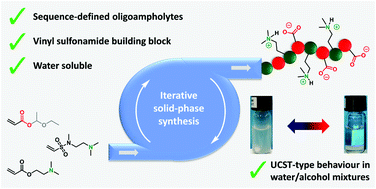Sequence-defined oligoampholytes using hydrolytically stable vinyl sulfonamides: design and UCST behaviour†
Abstract
Polyampholytes, widely investigated for their distinct properties, are typically prepared via conventional polymerisation techniques. This results in an ensemble of polymer chains with variation in molecular parameters such as length, ratio of charged groups and monomer order, which could influence their behaviour. Here, uniform oligoampholytes with precisely positioned negatively charged carboxylate and positively charged ammonium side-chains were synthesised using an iterative solid-phase synthesis strategy based on thiolactone chemistry. The amine side-chains were initially introduced via an acrylate, resulting in an amino-functionalised β-thioester that was shown to be susceptible to transesterification and hydrolysis, even under ambient conditions. While increasing the spacer length between the β-thioester and amine functionality could slow down this undesired side-reaction, it could not be completely suppressed. On the other hand, a tertiary amine-bearing vinyl sulfonamide proved to be a viable, hydrolytically stable alternative to introduce this moiety. The resulting uniform oligoampholytes are soluble in water and show UCST-type thermoresponsive behaviour in 85 vol% isopropanol/water mixtures.

- This article is part of the themed collection: Synthetic Methodologies for Complex Macromolecular Structures


 Please wait while we load your content...
Please wait while we load your content...